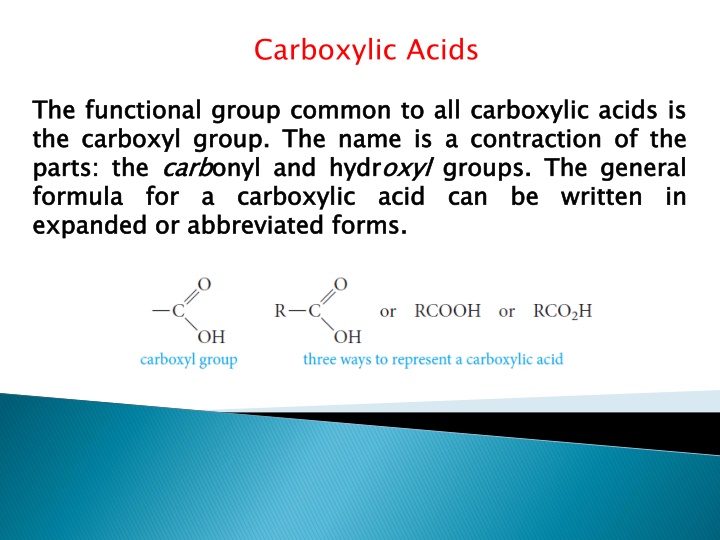
Understanding Carboxylic Acids and Their Properties
Explore the world of carboxylic acids, their nomenclature, structures, and physical properties. Learn how to name carboxylic acids, discover dicarboxylic acids, examine acyl groups, and understand the unique characteristics of these compounds. Dive into the polar nature, hydrogen bonding abilities, and solubility of carboxylic acids in this comprehensive guide.
Download Presentation

Please find below an Image/Link to download the presentation.
The content on the website is provided AS IS for your information and personal use only. It may not be sold, licensed, or shared on other websites without obtaining consent from the author. If you encounter any issues during the download, it is possible that the publisher has removed the file from their server.
You are allowed to download the files provided on this website for personal or commercial use, subject to the condition that they are used lawfully. All files are the property of their respective owners.
The content on the website is provided AS IS for your information and personal use only. It may not be sold, licensed, or shared on other websites without obtaining consent from the author.
E N D
Presentation Transcript
Carboxylic Acids The the parts formula expanded The functional the carboxyl parts: : the formula for expanded or functional group carboxyl group the carb for a a carboxylic or abbreviated group common group. . The carbonyl carboxylic acid abbreviated forms common to The name onyl and all carboxylic contraction of oxyl groups acid can forms. . to all carboxylic acids acids is is of the general written in name is is a a contraction and hydr the hydroxyl groups. . The can be The general be written in
Nomenclature of Acids Nomenclature of Acids Many of carboxylic acid have common names. These names usually come from some Latin or Greek word that indicates the original source of the acid.
To obtain the IUPAC name of a carboxylic acid, we replace the final e in the name of the corresponding alkane with the suffix -oic and add the word acid. Substituted acids are named in two ways. In the IUPAC system, the chain is numbered beginning with the carboxyl carbon atom, and substituents are located in the usual way. If the common name of the acid is used, substituents are located with Greek letters, beginning with the a-carbon atom
Dicarboxylic acids occur in nature and go by their common names, which arebased Dicarboxylic acids acids Many names, which Many dicarboxylic dicarboxylic acids occur in nature and go by their common arebased on their source on their source
Particular corresponding Particular corresponding acid acyl acyl groups acid by groups by changing are are named the - -ic ic ending named from from the the changing the ending to to - -yl yl. .
Physical Properties of Acids The first members of the carboxylic acid series are colorless liquids with sharp or unpleasant odors. Physical Properties of Acids Carboxylic acids are polar. Like alcohols, they form hydrogen bonds with themselves or with other molecules Carboxylic acids form dimers, with the individual units neatly held together by two hydrogen bonds between the electronrich oxygens and the electron-poor hydrogens Hydrogen bonding also explains the water solubility of the lower molecular weight carboxylic acids.
Acidity and Acidity Constants Acidity and Acidity Constants The stronger The larger stronger the larger the the acid the value acid. . value of of Ka Ka or or the the smaller smaller the the value value of of p pKa Ka, , the the
What Makes Carboxylic Acids Acidic? What Makes Carboxylic Acids Acidic?
What Makes Carboxylic Acids Acidic? What Makes Carboxylic Acids Acidic?
EXAMPLE EXAMPLE Solution
PROBLEM 2
PROBLEM. Ka
Preparation of Acids Oxidation of Primary Alcohols and Aldehydes
Preparation of Acids Oxidation of Aromatic Side Chains !
Preparation of Acids Reaction of Grignard Reagents with Carbon Dioxide Reaction of Grignard Reagents with Carbon Dioxide carbonyl of the HCl. . carbonyl group the intermediate group of of carbon carboxylate salt carbon dioxide dioxide to salt with to give with a a give acids, mineral acids, after mineral acid after protonation acid like protonation of like aqueous intermediate carboxylate aqueous HCl
PROBLEM. PROBLEM.
Preparation of Acids Hydrolysis of Cyanides (Nitriles) H.W : Write The mechanism of nitrile hydrolysis
PROBLEM. PROBLEM.
Note Note
Reaction of Acids Reaction of Acids



















